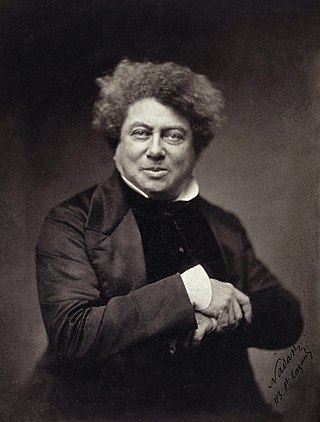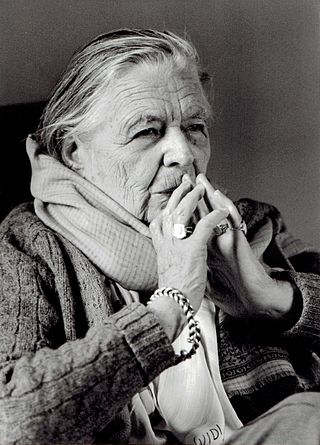
Alexandre Dumas, also known as Alexandre Dumas père, was a French novelist and playwright.

Marguerite Yourcenar was a Belgian-born French novelist and essayist who became a US citizen in 1947. Winner of the Prix Femina and the Erasmus Prize, she was the first woman elected to the Académie Française, in 1980. In 1965, she was nominated for the Nobel Prize in Literature.

André-Aimé-René Masson was a French artist.

Marguerite Catherine Perey was a French physicist and a student of Marie Curie. In 1939, Perey discovered the element francium by purifying samples of lanthanum that contained actinium. In 1962, she was the first woman to be elected to the French Académie des Sciences, an honor denied to her mentor Curie. Perey died of cancer in 1975.

La damnation de Faust, Op. 24 is a work for four solo voices, full seven-part chorus, large children's chorus and orchestra by the French composer Hector Berlioz. He called it a "légende dramatique". It was first performed at the Opéra-Comique in Paris on 6 December 1846.
Marie Louise Lévêque de Vilmorin was a French novelist, poet and journalist. Vilmorin was best known as a writer of delicate but mordant tales, often set in aristocratic or artistic milieu.

Faust is an opera in five acts by Charles Gounod to a French libretto by Jules Barbier and Michel Carré from Carré's play Faust et Marguerite, in turn loosely based on Johann Wolfgang von Goethe's Faust, Part One. It debuted at the Théâtre Lyrique on the Boulevard du Temple in Paris on 19 March 1859, with influential sets designed by Charles-Antoine Cambon and Joseph Thierry, Jean Émile Daran, Édouard Desplechin, and Philippe Chaperon.

Dialogues des Carmélites, FP 159, is an opera in three acts, divided into twelve scenes with linking orchestral interludes, with music and libretto by Francis Poulenc, completed in 1956. Poulenc wrote the libretto for his second opera after the work of the same name by Georges Bernanos, itself based on The Song at the Scaffold by Gertrud von Le Fort. This is a fictionalized version of the story of the Martyrs of Compiègne, Carmelite nuns who, in 1794 during the closing days of the Reign of Terror during the French Revolution, were guillotined in Paris for refusing to renounce their vocation.

Marie-Catherine Le Jumel de Barneville, Baroness d'Aulnoy, also known as Countess d'Aulnoy, was a French author known for her literary fairy tales. Her 1697 collection Les Contes des Fées coined the literary genre's name and included the first story to feature "Prince Charmant" or Prince Charming.
The Lady of the Camellias, sometimes called Camille in English, is a novel by Alexandre Dumas fils. First published in 1848 and subsequently adapted by Dumas for the stage, the play premiered at the Théâtre du Vaudeville in Paris, France, on February 2, 1852. It was an instant success. Shortly thereafter, Italian composer Giuseppe Verdi set about putting the story to music in the 1853 opera La traviata, with female protagonist Marguerite Gautier renamed Violetta Valéry.
French Renaissance literature is, for the purpose of this article, literature written in French from the French invasion of Italy in 1494 to 1600, or roughly the period from the reign of Charles VIII of France to the ascension of Henry IV of France to the throne. The reigns of Francis I and his son Henry II are generally considered the apex of the French Renaissance. After Henry II's unfortunate death in a joust, the country was ruled by his widow Catherine de' Medici and her sons Francis II, Charles IX and Henry III, and although the Renaissance continued to flourish, the French Wars of Religion between Huguenots and Catholics ravaged the country.

Henri Desmarets was a French composer of the Baroque period primarily known for his stage works, although he also composed sacred music as well as secular cantatas, songs and instrumental works.

Marguerite de Navarre, also known as Marguerite of Angoulême and Margaret of Navarre, was a princess of France, Duchess of Alençon and Berry, and Queen of Navarre by her second marriage to King Henry II of Navarre. Her brother became King of France, as Francis I, and the two siblings were responsible for the celebrated intellectual and cultural court and salons of their day in France. Marguerite is the ancestress of the Bourbon kings of France, being the mother of Jeanne d'Albret, whose son, Henry of Navarre, succeeded as Henry IV of France, the first Bourbon king. As an author and a patron of humanists and reformers, she was an outstanding figure of the French Renaissance. Samuel Putnam called her "The First Modern Woman".

Marie of the Incarnation, OCD, also known as Madame Acarie, was the foundress of the Discalced Carmel in France and later became an extern sister of the order.

Claudine Monteil is a French writer, women's rights specialist, historian, and a former French diplomat.

Juliette Benzoni was a French author and international bestseller in several genres, including historical romance, historical fiction, mystery and screenwriting. In 1998, at the age of 78, she received the Chevalier de l'Ordre National from President Jacques Chirac.
Marie de Romieu was a 16th-century French poet from Viviers, France. Although her exact date of birth is unknown, she was most likely born between 1526 and 1545, and died around 1589. Like her origins, most of her life remains a mystery. She is mostly known for her poetic discourse on the superiority of women, as well as an attributed French translation of a work by Italian author Alessandro Piccolomini, which provided behavioral and societal instructions for young ladies and their mothers.

Anne de Graville or Anne Malet de Graville (c.1490–c.1540) was a French Renaissance poet, translator, book collector, and lady-in-waiting to Queen Claude of France. She hailed from one of the most prominent families in the country and overcame scandal to become a well-respected literary figure at the royal court. In addition to authoring two texts, she was an avid collector of books and manuscripts.
Éditions des Femmes is a French feminist publishing house that was launched in 1972, mainly by women of the collective Psychanalyse et politique led by Antoinette Fouque, with other activists of the MLF, and funded by the patron Sylvina Boissonnas. They offer works written by women, women focused issues related to human rights and women's empowerment, women's creativity and reflection, and also produce audio books.

Michèle Sarde, is a French writer, born in 1939. She taught French literature and culture, together with gender and intercultural studies at Georgetown University, Washington D.C., from 1970 to 2000. She is now a Professor emerita at that university and lives in Chile and France.















